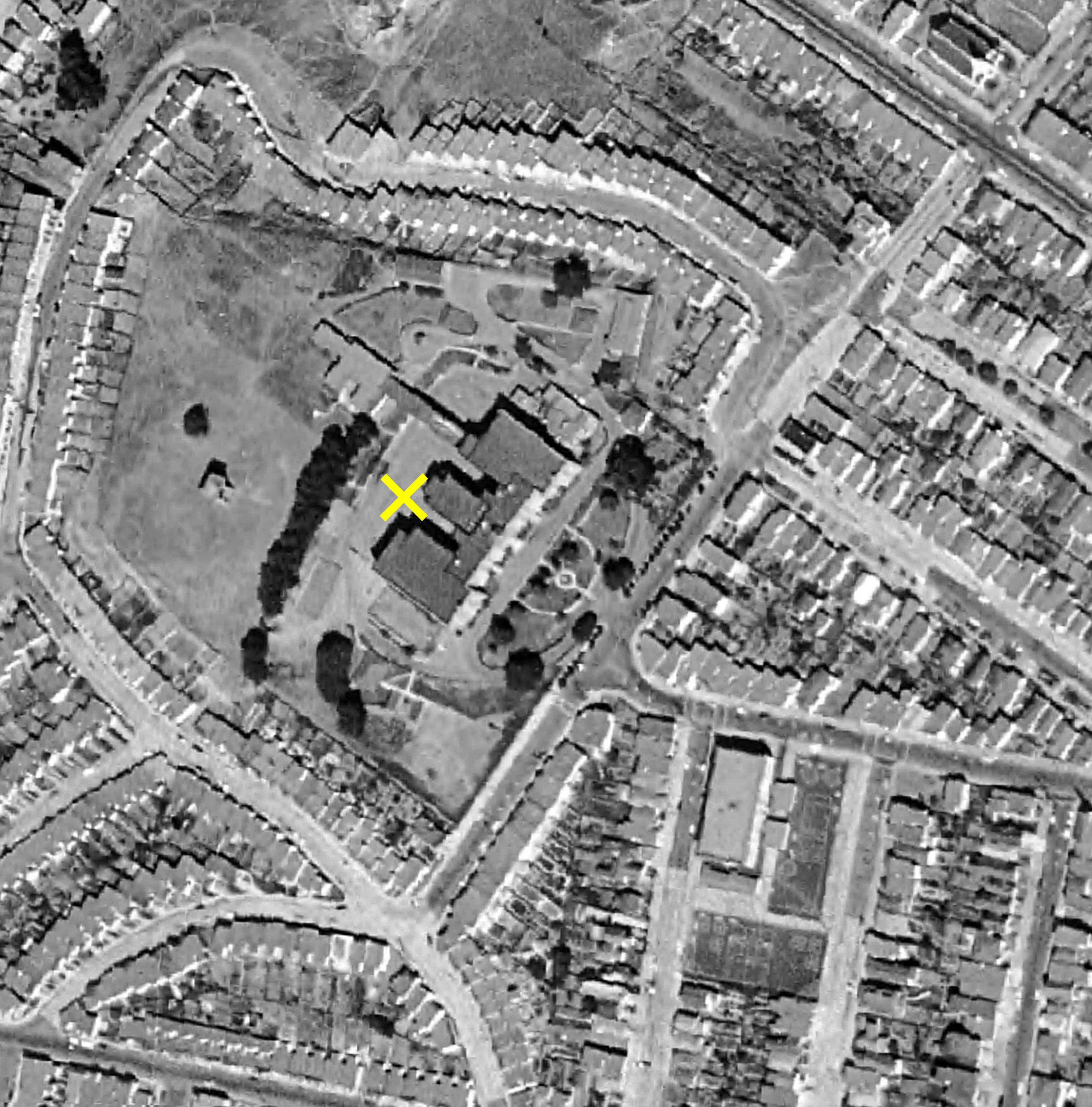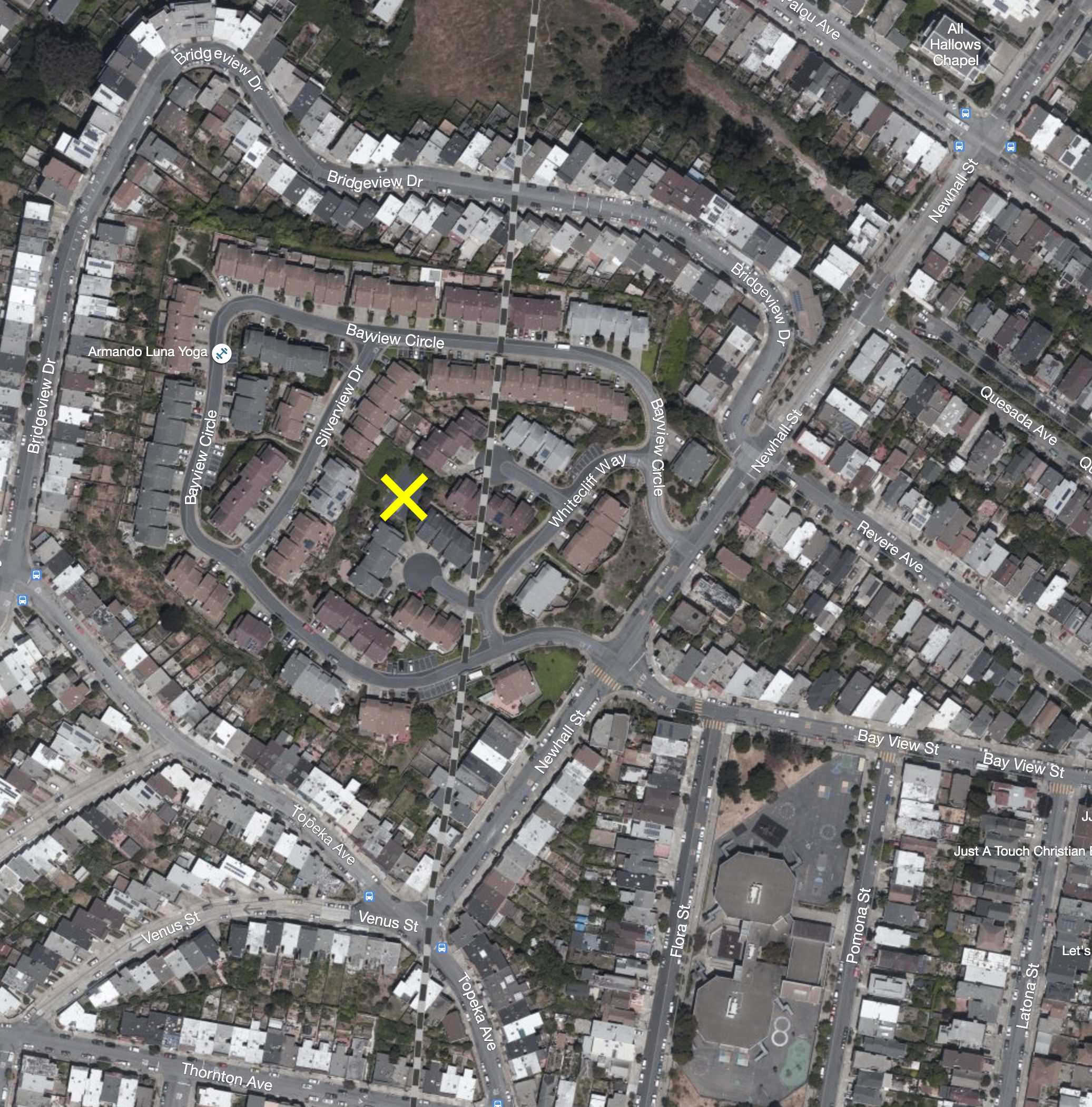Then … Anna is beside herself not knowing why Joe is avoiding her. She visits the orphanage where he was brought up to see if the nuns there could shed some light.
… in the 1950s … CitySleuth came across a 1950s photo of this same playground, viewed from the opposite direction. This was Mount St. Joseph’s School for orphaned girls at 1700 Newhall Street in the Bayview neighborhood (map). The movie was filmed around this same time with a cast of boys in place of the real orphans. The site was described in detail here in an earlier post.
The school was closed in 1977, replaced in 1984 by the Silverview Terrace subdivision pictured in the aerial view below. ‘X’ marks where the playground used to be; tap or click the image to see a matching 1956 aerial of the school.
Then … Anna was amazed to hear from the nun that she knew Joe as a motorcycle cop.
… and Now, a smaller playground has survived at the same spot in the heart of the subdivision.
She heads straight to the precinct police station but runs into a wall of silence, having to leave without learning anything more of Joe’s history.
Then … Joe is mortified by the news that Malatesta lied about his alibi; he’s now convinced of his murderous guilt. Conflicted, he goes on a walk to try to gather his thoughts. When Malatesta drives up, Joe spurns him and walks away.
… and Now, this was filmed on the upper level of Calhoun Terrace in Telegraph Hill. Note the Ferry building in the distance Then and Now. Note too the vintage street lamp mounted on the wall and the wall’s embossed art deco patterns.
Calhoun Terrace is an unusual two level cul-de-sac just two blocks away from where Joe was staying, at Malatesta’s house (seen earlier in the movie) next to the Montgomery Steps.
In a scene in the 1952 movie The Sniper the eponymous killer hid behind that same lamppost awaiting a victim as she exited her home at 36 Calhoun Terrace via an exterior stairway.
… and Now, from the same viewpoint we see that the original lamppost is still there but the building’s stairway has since been enclosed (the front corner of 36 Calhoun can be seen at the left edge of the Now image above). The lamppost sits atop one of the art deco chevron decorations cast into the concrete wall.
Calhoun Terrace has an interesting history … It has been seen in several other movies, The House On Telegraph Hill, Vertigo and Days Of Wine And Roses amongst them. It was the site of the notorious Hoeffler compound, a revolving-door home to artists and writers in the early 20th century. Diego Rivera and Frida Kahlo lived at 42 Calhoun in 1940. Here’s an 1860s photo taken when the street used to connect through to Green Street but before the lower level was established. A descending row of Union Street houses faces us in the background.
The double cul-de-sac is accessed from the end of Union Street at the top of Telegraph Hill. This whimsical realistic drawing by Paul Madonna captures it. (He too picked up on the wall’s art deco touches).
There’s a sheer drop below Calhoun, accentuated by the blatantly illegal quarrying activities of the infamous Gray Brothers at the turn of the 20th century. In this recent upslope view of the precarious cantilevered roadway we see the lamppost pictured in the images above, with 36 Calhoun at far right. Photo by Chris Carlsson.
And one last piece of related trivia … After decades of mutilating the hill and flaunting the law through repeated dynamiting, bribing and cheating, George Gray, one of the brothers, was shot and killed by an employee, Sicilian immigrant Joe Lococco, for not paying his wages. So that was that. End of dynamiting, end of story.
Meanwhile, back at the house, Joe cannot look his fiancé Anna, Malatesta’s cousin, in the eye. She cannot understand the sudden change in him and pleads, to no avail, for an explanation.
[Dear readers: For the foreseeable future CitySleuth is compelled to use Google Street images for most of his ‘Now’ photos. Here’s looking forward to the end of the scourge. And Kudos to Google!].
From their stakeout on the corner of Clay and Mason the G-Men observe the suspect carefully crating his painting then handing it over to an Express Company truck.
Then … They follow the truck through town; in this shot it’s passing a well-known Nob Hill hotel.
… and Now, it’s the Mark Hopkins on the corner of California and Mason (map).
Then … the camera pans down California, tracking the truck as it goes by an oncoming cable car.
… and Now, in today’s view a distant Bay Bridge tower is barely visible between the proliferation of Financial District high-rises. But in the foreground the Fairmont hotel was then, and still is, on the left. On the right is the Stanford Court hotel which opened in 1972 in the former Stanford Court Apartments, built in 1912 on the site of railroad baron Leland Stanford’s estate after it was destroyed in the 1906 earthquake and fire. Note the resident’s balconies in the movie view, since removed.
Then … the truck heads to the Embarcadero and turns into its destination. The elevated freeway leading to the Bay Bridge spans the background.
… and Now, here’s the same span today. The view looks north towards the bridge.
Then … The truck’s Embarcadero destination is Pier 36 in South Beach. The ocean liner berthed at the time was Matson Lines’ S.S. Matsonia. Shortly after being built in 1926 as the S.S. Malolo, it collided with another ship, suffering damage comparable to that of the ill-fated R.M.S Titanic . But it survived, despite taking on massive water, thanks to an improved multi-hull influenced by the Titanic’s failed design. Renamed the Matsonia, it was used as a troop ship during WWII but had reverted back to its West Coast-to-Hawaii luxury cruises by the time this was filmed.
… Pier 36 in 2011 … the pier is pictured here shortly before it was pulled down to clear the area for a new public park space, the Brannan Street Wharf (map). This utilitarian pier lacked the grand bulkhead seen on many of the other piers along the Embarcadero. The sunlit fence corresponds to that seen above.
… and Now, today’s matching view looks across the south edge of the long, narrow park (rather a grand name for what is just really a stretch of grassy and seating areas). Pier 36 may be gone but Pier 38 on the right, also visible above, is still there.
O’Hara and Grayson take note of the package’s destination - London, England - but let it go through to so as not to alert the spy ring to the tightening noose.
Joe has a hard time tracking down Charlie Cuneo but fortuitously Malatesta invites him over for dinner. He relates how he and Malatesta played snooker together at the Vallejo Social Club until one a.m. on the night Father Tomasino was murdered. To Joe’s great relief his concern over Malatesta’s possible guilt is dispelled.
Then … But his precinct Sergeant arrives with disturbing new information. A detective had been following Cuneo that night on another case and witnessed him meet Malatesta at another club that backed onto the alley where the priest was killed then left for several hours leaving Malatesta behind. Cuneo had lied; Malatesta’s alibi was blown.
… and Now, they were at the cul-de-sac at the top of the Montgomery Steps, described in more detail in an earlier post.
Then … Joe asks to be dropped off; they pull up in front of a theater - its marquee is partly visible on the left.
… a vintage photo … This was the Palace Theater at Washington Square park at the junction of Columbus and Powell in North Beach (map). Here’s a c. 1970 image of the theater taken at a time when it was showing Chinese movies (the theater would later be renamed the Pagoda Palace). (The theater was briefly seen in Woody Allen’s 1972 movie Play It Again Sam).
… and Now, After being closed for years the theater was demolished in 2013 when it was deemed the ideal spot to extract the two boring machines that had dug the twin Central Subway tunnels extending the T-Third Street line from near the Giant’s ballpark into Chinatown. It is now a retail/condominium structure, retaining the blade sign in a nod to its past. More’s the pity it didn’t become a subway station (the tunnel had already been extended to here, right?).
Then … Across the park we see Saints Peter and Paul Church and Coit Tower.
… and Now, the same view below also shows the statue mostly obscured by the car, above. It’s a memorial to the Volunteer Fire Dept. of 1839-1866 who protected the city during several conflagrations before the first city fire department was created.
… in 1933 … The statue’s dedication ceremony was attended in force by firemen and residents with vivid memories of the city’s 1906 fire. The church is behind it, as too is Coit Tower which had been completed only months earlier.


